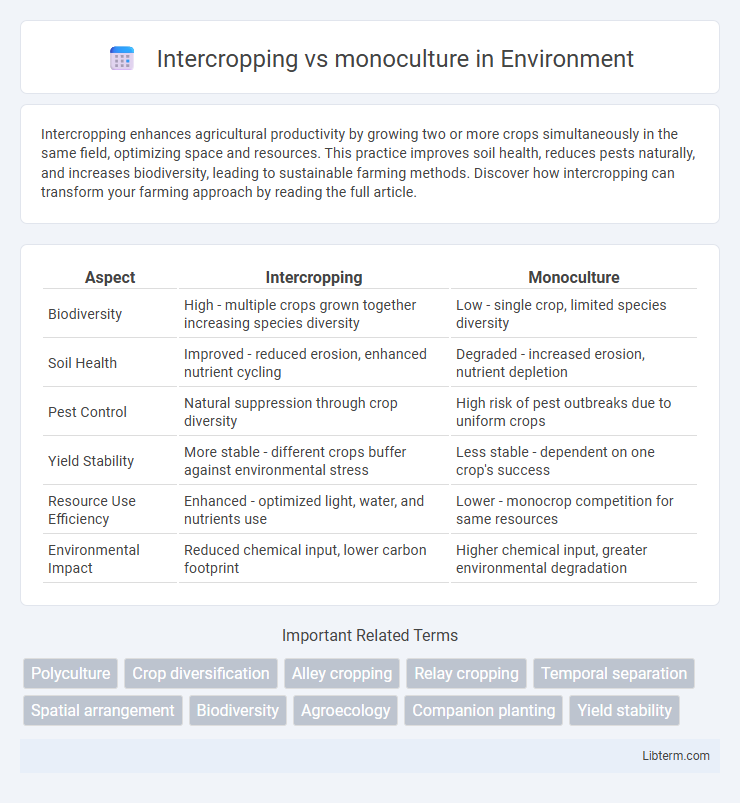Intercropping enhances agricultural productivity by growing two or more crops simultaneously in the same field, optimizing space and resources. This practice improves soil health, reduces pests naturally, and increases biodiversity, leading to sustainable farming methods. Discover how intercropping can transform your farming approach by reading the full article.
Table of Comparison
| Aspect | Intercropping | Monoculture |
|---|---|---|
| Biodiversity | High - multiple crops grown together increasing species diversity | Low - single crop, limited species diversity |
| Soil Health | Improved - reduced erosion, enhanced nutrient cycling | Degraded - increased erosion, nutrient depletion |
| Pest Control | Natural suppression through crop diversity | High risk of pest outbreaks due to uniform crops |
| Yield Stability | More stable - different crops buffer against environmental stress | Less stable - dependent on one crop's success |
| Resource Use Efficiency | Enhanced - optimized light, water, and nutrients use | Lower - monocrop competition for same resources |
| Environmental Impact | Reduced chemical input, lower carbon footprint | Higher chemical input, greater environmental degradation |
Understanding Intercropping and Monoculture
Intercropping involves growing two or more crops simultaneously on the same plot to enhance biodiversity, nutrient utilization, and pest resistance, while monoculture refers to cultivating a single crop over a large area, which simplifies management but increases vulnerability to pests and soil degradation. Intercropping systems improve soil health by promoting nutrient cycling and reducing erosion, whereas monoculture often leads to nutrient depletion and requires higher chemical inputs. Understanding these differences is crucial for sustainable agriculture, as intercropping supports ecosystem resilience and long-term productivity compared to the intensive resource demands of monoculture.
Historical Overview of Farming Methods
Intercropping, practiced since ancient civilizations, involves growing multiple crops simultaneously to enhance biodiversity, soil health, and pest control, contrasting sharply with monoculture's single-crop focus developed during the Industrial Revolution to maximize mechanization and yield. Early agricultural societies, such as those in Mesopotamia and Mesoamerica, relied on intercropping techniques like the "Three Sisters" method to sustain soil fertility and reduce risks associated with crop failure. In contrast, monoculture gained prominence with advancements in agricultural machinery and chemical inputs in the 19th and 20th centuries, leading to large-scale, uniform planting but often resulting in increased vulnerability to pests and soil degradation.
Key Principles of Intercropping
Intercropping involves cultivating two or more crops in proximity to enhance biodiversity, resource use efficiency, and pest management compared to monoculture systems that grow a single crop. Key principles of intercropping include spatial arrangement for optimal light and nutrient sharing, temporal complementarity by staggering planting and harvesting times, and complementary crop selection based on root depth and growth habits to minimize competition. These strategies improve soil health, reduce reliance on chemical inputs, and increase overall productivity per unit area.
Advantages of Intercropping Systems
Intercropping systems enhance biodiversity by growing multiple crop species simultaneously, leading to improved pest and disease control compared to monoculture. These systems increase land-use efficiency and total crop yield through complementary resource utilization such as sunlight, water, and nutrients. Intercropping also promotes soil health by reducing erosion and enhancing nutrient cycling, which supports sustainable agricultural productivity.
Benefits and Challenges of Monoculture
Monoculture agriculture enables high efficiency and mechanization, leading to increased crop uniformity and easier pest management through targeted treatments. It often results in higher short-term yields due to specialization on a single crop species, but it poses significant challenges such as increased vulnerability to pests and diseases, soil nutrient depletion, and reduced biodiversity. Long-term soil health degradation and reliance on chemical inputs are critical issues that necessitate careful management to sustain productivity.
Impact on Crop Yield and Productivity
Intercropping enhances crop yield and productivity by promoting resource use efficiency, improving soil fertility, and reducing pest and disease incidence compared to monoculture systems. Diverse plant species grown together maximize light capture, nutrient uptake, and water utilization, leading to higher overall biomass and grain output per unit area. Monoculture often results in soil nutrient depletion and greater vulnerability to pests, limiting long-term productivity.
Effects on Soil Health and Fertility
Intercropping enhances soil health by increasing biodiversity, promoting beneficial microbial activity, and improving nutrient cycling, which leads to higher soil fertility compared to monoculture systems. Monoculture often depletes specific nutrients, reduces organic matter, and increases vulnerability to soil erosion and pests. Incorporating diverse crop species in intercropping improves soil structure, moisture retention, and long-term productivity, supporting sustainable agricultural ecosystems.
Pest and Disease Management Comparisons
Intercropping enhances pest and disease management by promoting biodiversity, which disrupts pest colonization and reduces the spread of pathogens compared to monoculture systems. Diverse crop combinations in intercropping create physical and chemical barriers that lower pest populations and disease incidence, reducing reliance on chemical pesticides. Monoculture, with its uniform planting, often facilitates rapid pest outbreaks and increased vulnerability to diseases, leading to higher economic and ecological risks.
Environmental Sustainability Considerations
Intercropping enhances environmental sustainability by improving soil health through diversified root systems that reduce erosion and enhance nutrient cycling, unlike monoculture which often depletes soil nutrients and increases vulnerability to pests and diseases. Intercropping promotes biodiversity by supporting a wider range of beneficial insects and microorganisms, contributing to ecosystem resilience and reduced chemical inputs. In contrast, monoculture relies heavily on synthetic fertilizers and pesticides, leading to greater environmental degradation and reduced long-term agricultural sustainability.
Choosing the Right System for Your Farm
Intercropping enhances biodiversity by cultivating multiple crops simultaneously, leading to improved pest management and soil fertility compared to monoculture. Farmers benefit from risk reduction and higher overall yields by selecting intercropping systems tailored to local climate, soil type, and crop compatibility. Monoculture remains advantageous for mechanization and uniform crop management in large-scale operations but requires careful consideration of crop rotation to prevent soil degradation.
Intercropping Infographic

 libterm.com
libterm.com